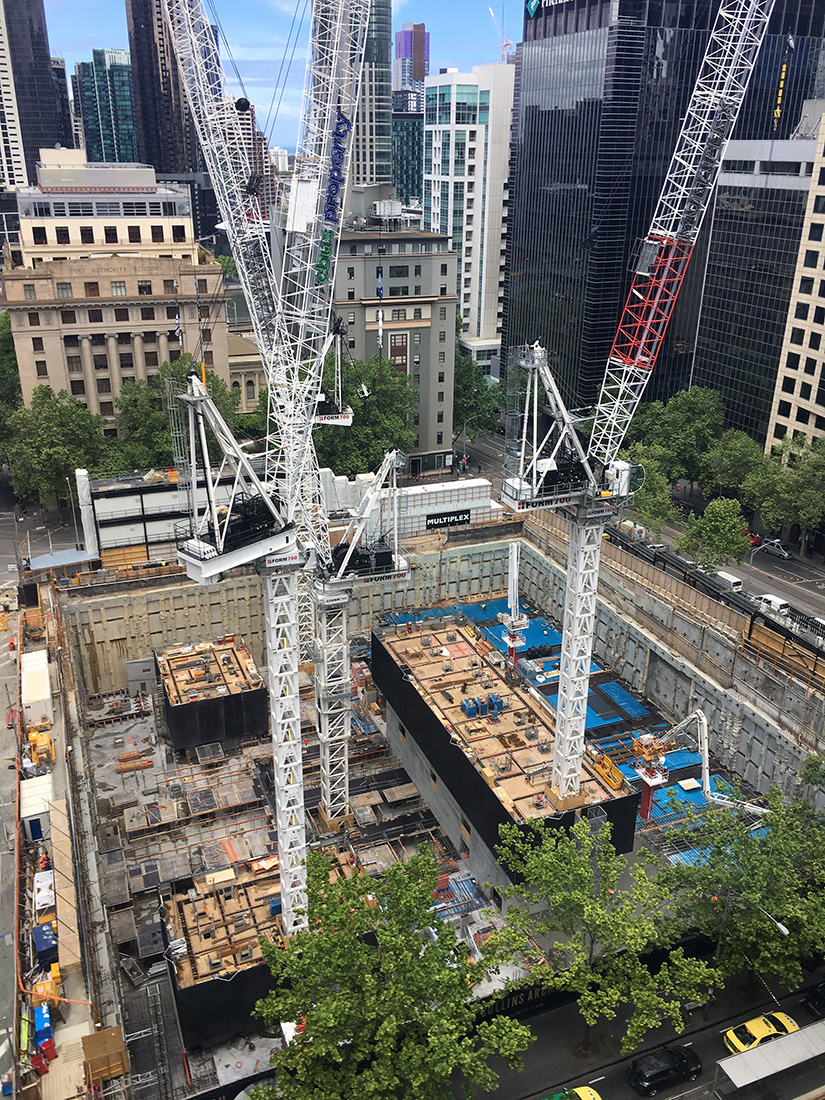Melbourne Office Investment – Buy Long Term
15th Dec 2017
A Melbourne Perspective: assess the supply cycle carefully and look for asset regeneration opportunities in 2018.
Recently, we’ve all read mixed commentary from various experts generalising about the cycle of investment grade property markets in Australia. The consensus seems to follow a buy-side theme promoted with sound arguments such as yield spread above long-term bonds, forecast rental growth, weight of capital, population growth, and so on.
Over the last 3-6 months, I’ve taken on board the acquisition preferences of investors and fund managers. “We’re still looking to buy prime office property in Melbourne. We know cap rates are tight but we see further compression because rents will rise and it will ultimately justify our decision”.
For over a quarter of a century, Melbourne has trailed Sydney with respect to prime grade office rents, often by up to 50%. Yes, Melbourne remains relatively cheap. Why? There has been an abundance of developable land in, and on the edge of, the Central Business District.
Whenever effective rents reach feasibility levels, more office buildings have been developed. This leads to additional supply which, depending on economic conditions, takes time to absorb.

Ignoring the glut of new office towers completed between 1990 – 1992 (can we really ignore it? …it took nearly a decade to trade through the extra supply), new supply has been more progressive over the last decade, developed on solid fundamentals, and strong pre-commitments. Docklands’ evolution is testament to that; lead by developers Lend Lease, Grocon, Equiset, and Walker Corporation.
However. Melbourne is about to experience a surge of new office towers.
Eleven projects are under construction with completion dates between early 2019 to late 2020. At this stage, approximately 185,000sqm remains uncommitted.
The tenants that are relocating to these new towers will vacate Prime Grade properties, probably freeing up more than 180,000sqm of high quality space after asset refurbishments and regeneration programmes. This means Melbourne will have enough supply to sustain even the most historically strong absorption rates until at least 2022. The long-term average absorption is ~50,000sqm.
Now, back to the presumption of rental growth underpinning an aggressive acquisition cap rates. If effective rentals flat line, or even fall during 2019-2023, what effect will it have on your IRR?
Let me slightly balance this line of thinking. During 2018, landlords will seek to maximise rentals, primarily due to the current low vacancy rate, thereby setting new benchmarks. Most of the new developments have net face rents well into the $600’s per square metre. Existing towers are also capturing this upside, and rental growth will continue well into 2018.
Melbourne’s Prime Grade vacancy is currently circa 6.1%, which means more than 180,000sqm remains physically available. Enough to provide small to mid-size tenants with plenty of options, which forces landlords to compete, mainly through the application of incentives.
Larger corporations and government agencies (exceeding 5,000sqm) will find it more difficult to find contiguous accommodation in the short term.
Tenants seeking new space in 2018 should commit early. Vacancy will fall to ~4% by the end of the year. Structurally, this is a fully committed market.
Following the supply cycle, we should expect Melbourne Prime Grade vacancy to gradually increase to around 8%. A sustained period of tightening will occur beyond that as quality development sites become scarce.
Tactically, investors in for the long haul should manage lease expiry risk early, and seek to renegotiate leases to avoid renewals in the supply window.
Despite this hiatus, Melbourne will provide significant effective rental growth beyond this supply cycle.
For existing assets, implementing regeneration strategies will undoubtedly improve the leasing profile and income potential, and better position individual buildings for long term out-performance. The best current examples in Melbourne include Rialto, and Pembroke’s 161 Collins Street.
Alternatively, if a divestment programme is on your agenda in the short term – I’d recommend getting your asset on the market as soon as possible.
Acquisitions, and comprehensive investment in asset regeneration, will reward investors with sound long term returns; but appreciate the Melbourne nuances of location, address, accessibility, services, and architecture in order to maximise any investment.
Integrated asset regeneration is building and location specific. It includes physical improvement, together with commercial, social and digital place-making initiatives.
Think long term, and benefit from great strategic planning.

Melbourne Office Investment – Buy Long Term
A Melbourne Perspective: assess the supply cycle carefully and look for asset regeneration opportunities in 2018.
Recently, we’ve all read mixed commentary from various experts generalising about the cycle of investment grade property markets in Australia. The consensus seems to follow a buy-side theme promoted with sound arguments such as yield spread above long-term bonds, forecast rental growth, weight of capital, population growth, and so on.
Over the last 3-6 months, I’ve taken on board the acquisition preferences of investors and fund managers. “We’re still looking to buy prime office property in Melbourne. We know cap rates are tight but we see further compression because rents will rise and it will ultimately justify our decision”.
For over a quarter of a century, Melbourne has trailed Sydney with respect to prime grade office rents, often by up to 50%. Yes, Melbourne remains relatively cheap. Why? There has been an abundance of developable land in, and on the edge of, the Central Business District.
Whenever effective rents reach feasibility levels, more office buildings have been developed. This leads to additional supply which, depending on economic conditions, takes time to absorb.
Ignoring the glut of new office towers completed between 1990 – 1992 (can we really ignore it? …it took nearly a decade to trade through the extra supply), new supply has been more progressive over the last decade, developed on solid fundamentals, and strong pre-commitments. Docklands’ evolution is testament to that; lead by developers Lend Lease, Grocon, Equiset, and Walker Corporation.
However. Melbourne is about to experience a surge of new office towers.
Eleven projects are under construction with completion dates between early 2019 to late 2020. At this stage, approximately 185,000sqm remains uncommitted.
The tenants that are relocating to these new towers will vacate Prime Grade properties, probably freeing up more than 180,000sqm of high quality space after asset refurbishments and regeneration programmes. This means Melbourne will have enough supply to sustain even the most historically strong absorption rates until at least 2022. The long-term average absorption is ~50,000sqm.
Now, back to the presumption of rental growth underpinning an aggressive acquisition cap rates. If effective rentals flat line, or even fall during 2019-2023, what effect will it have on your IRR?
Let me slightly balance this line of thinking. During 2018, landlords will seek to maximise rentals, primarily due to the current low vacancy rate, thereby setting new benchmarks. Most of the new developments have net face rents well into the $600’s per square metre. Existing towers are also capturing this upside, and rental growth will continue well into 2018.
Melbourne’s Prime Grade vacancy is currently circa 6.1%, which means more than 180,000sqm remains physically available. Enough to provide small to mid-size tenants with plenty of options, which forces landlords to compete, mainly through the application of incentives.
Larger corporations and government agencies (exceeding 5,000sqm) will find it more difficult to find contiguous accommodation in the short term.
Tenants seeking new space in 2018 should commit early. Vacancy will fall to ~4% by the end of the year. Structurally, this is a fully committed market.
Following the supply cycle, we should expect Melbourne Prime Grade vacancy to gradually increase to around 8%. A sustained period of tightening will occur beyond that as quality development sites become scarce.
Tactically, investors in for the long haul should manage lease expiry risk early, and seek to renegotiate leases to avoid renewals in the supply window.
Despite this hiatus, Melbourne will provide significant effective rental growth beyond this supply cycle.
For existing assets, implementing regeneration strategies will undoubtedly improve the leasing profile and income potential, and better position individual buildings for long term out-performance. The best current examples in Melbourne include Rialto, and Pembroke’s 161 Collins Street.
Alternatively, if a divestment programme is on your agenda in the short term – I’d recommend getting your asset on the market as soon as possible.
Acquisitions, and comprehensive investment in asset regeneration, will reward investors with sound long term returns; but appreciate the Melbourne nuances of location, address, accessibility, services, and architecture in order to maximise any investment.
Integrated asset regeneration is building and location specific. It includes physical improvement, together with commercial, social and digital place-making initiatives.
Think long term, and benefit from great strategic planning.